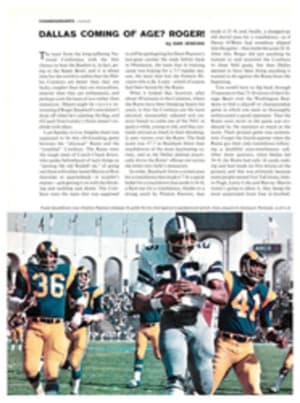
Nobody's a marshmallow at Fetlock U.
They let you bring your horse to school at Lake Erie College in Painesville, Ohio. And you can actually get credit for it. Of the 350 students attending this private liberal arts school for women, 125 are enrolled in riding classes and 50 of them have brought their own horses to the college's 600-acre Morley Farm, home of the Equestrian Studies Program. Stabling for 100 horses is available, and for students who don't have their own, the college provides mounts at no extra cost.
In addition to standard courses such as languages and psychology, the women study stable management, equine health, anatomy and physiology, promotion of equestrian events and judging. They spend from five to 30 hours a week in the saddle, learning to jump, school and show horses. They go abroad for their junior year, usually to England, and learn foreign methods of training and stable management. And there are 25 events a year they can compete in while they are at college. The top two are the Ohio Dressage Derby, which includes classes from the second level through Grand Prix quality on the horse-show circuit, and the Prix de Villes of North America, a fine junior team jumping competition.
Carla Gibbon, a 20-year-old junior from Silver Spring, Md. and a social psychology major, rides for an hour and a half every day, seven days a week, and says she has been riding all 20 years. "I sat on a horse before I learned to sit in a chair," she says. "I wouldn't know what to do with myself if I didn't ride. I'd be so bored. I don't swim or play tennis or ski. I'm not good at any sport except riding." Carla went to Lake Erie so she could keep on riding; others attend in order to learn how.
Morley Farm has an indoor ring measuring 100' by 225', a 75' by 130' warm-up area and seating for 1,000 spectators. Laddie Andahazy, a ruddy-faced Hungarian who is a former ballet dancer and U.S. cavalry officer, is responsible for the existence of Lake Erie's equestrian program, which began in 1956, and is its director. He often assumes ballet's second position (legs together, toes out) when teaching and is predictably enthusiastic about the value of the program. "I had one girl, when she came to me she was a marshmallow," he says. "She had no strength at all in her arms and legs. She was fat, she couldn't do anything, I had a hard time with her. But she kept trying, and when she finished the program she was physically strong, she had lost weight, she had self-assurance. It's a wonderful thing what can happen with these girls."
Two instructors, faculty members, stand at either end of the indoor ring while seven or eight horses and riders slowly circle them. It is a cold gray morning and the electric heaters set at intervals in the ceiling aren't doing much to cut the chill. A sign reading NO UNLEASHED CATS AND DOGS has been tacked up on an inside door. There is not a cat in sight, but five or six dogs roam about among the spectators' seats. They are quiet, friendly. Occasionally one of them pauses, props its front paws on the green pipe rail and checks out what's going on in the ring. A bunch of chirpy sparrows who live in the steel rafters keep winging down to the dirt floor of the arena, picking up straw, or whatever, and flying back to their nests.
The riders are cold. Their noses and fingers are red. The horses are probably cold, too. Everybody's breath is coining out white vapor. Associate Professor Sylvia Wilson shouts to a student, "Leg, leg, leg! Put the pressure on that left leg and pull, pull on the right rein. Good, good, much better." Round and around the riders go, trying to keep their horses close to the arena walls, practicing the same movements over and over again. Turning, trotting, stride lengthening, shortening. Now the horses are beginning to sweat. People, too. A girl unzips her jacket and pushes damp hair off her forehead.
Fences are set up and distances measured between them. The riders begin to practice the "in-and-out"—jump one fence, turn your horse and take another fence, one stride and then a third fence. This isn't easy. One horse keeps balking at the third fence. Wilson's collie, Rollicking Rob, erupts, barking and running crazily back and forth in the stands, eyes fixed on the ring. Rob, who obviously fancies himself a show judge, will not tolerate a horse's refusal to take a jump. This is the second dog Wilson has owned, and the first behaved this way, too. The horse finally makes it on the third try. The collie gives him a cold, critical look, but holds his tongue.
In warmer weather the action moves outdoors. The cross-country class learns to ride over difficult terrain with banks, ditches and slides. The fox-hunting class often goes out with the local Chagrin Valley Hunt Club.
Despite the popular association of horse-owning and wealth, Lake Erie's students are by no means all daughters of moneyed families. Most come from middle-class homes in such diverse cities as Montreal, Tuscaloosa and Bay City, Texas. They are fresh-faced and unaffected. Perhaps that comes from the hours spent schooling their horses and themselves. And riding and showing are sports in which women can compete with men. The horse itself makes up for the difference in strength between the sexes; skill is the decisive factor. Certainly Lake Erie women enjoy their courses. Officially, they are enrolled to earn a Bachelor of Arts degree, but mainly they're there because they love horses.
PHOTO
HOMEWORK: MARSHA DAHLGREN (LEFT) AND MARY VAUGHAN

